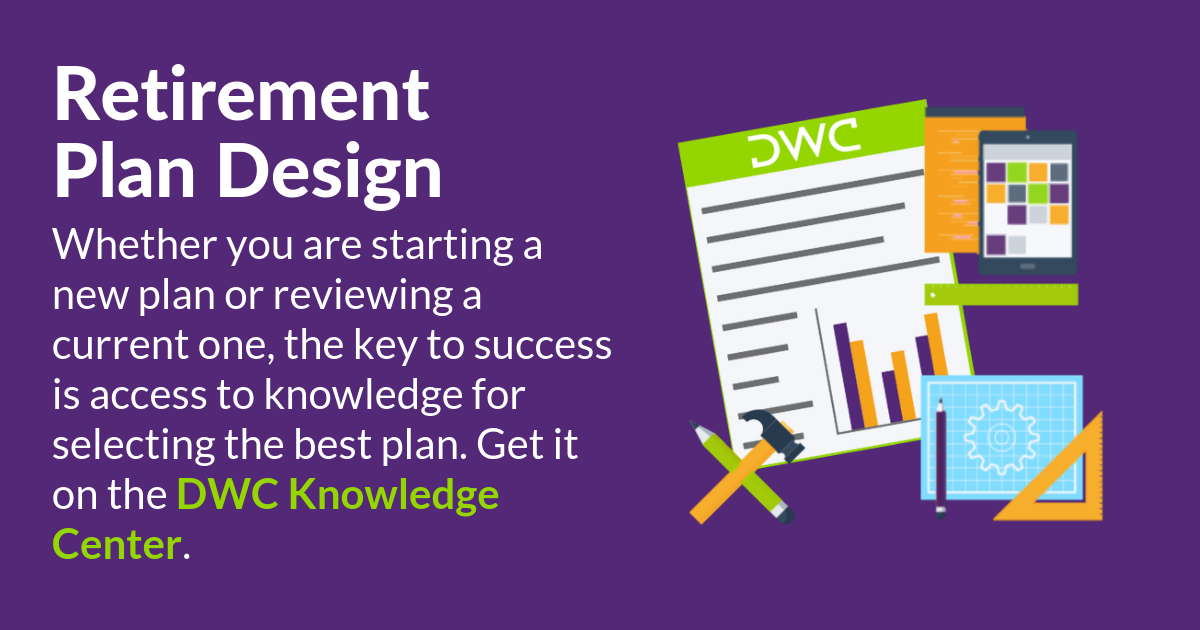Cash Balance Plans 101

You are currently maximizing the contributions to your 401(k) profit sharing plan. While this level of savings is beneficial, you still want to be able to save more, plus you are looking for additional tax savings. You’ve heard about a cash balance plan but aren’t sure what it is and why you would adopt one.
Welcome to DWC’s Knowledge Center - a great place to start learning about cash balance plans! This FAQ is meant to be a starting point, looking at the world of cash balance plans from a very high level. After you are familiar with this information, you will be ready to dive into our Cash Balance Corner, which takes a more detailed look with bi-monthly posts.
Because a cash balance plan is a type of defined benefit (DB) plan, we start with a primer on the differences between DB plans and defined contribution (DC) plans. As the names suggest, the key difference between DB and DC plans lies in how the eventual retirement benefit is determined. In a DC plan (think 401(k) or profit sharing plan), the design of the plan defines the contributions that go in. Contributions can typically be made by employees and by the company. Some are discretionary (employee deferrals and profit sharing contributions), while others are mandatory (safe harbor contributions). Those contributions go into a participant’s individual account, and the value of the account at retirement is a direct result of actual investment returns over the course of that participant’s working career. In other words, the participant takes on the investment risk.
A DB plan, on the other hand, guarantees the actual benefit each participant will ultimately receive, usually based on some combination of average compensation over time as well as length of service with the company. Each year, an actuary calculates that promised benefit based on the terms of the plan and determines what the asset level must be to provide that promised benefit at retirement. That, in turn, drives the amount the company must contribute each year to maintain adequate funding levels. Plan funding can only come from two sources – company contributions and investment gains. That means stronger than expected investment performance yields a lower company contribution, while lower returns mean larger company contributions. Thus, the company bears the investment risk in a DB plan.
With that as context, let’s dive in.
What is a cash balance plan?
A cash balance plan is a type of DB retirement plan the provides benefits to participants through a “hypothetical” account that is equal to the sum of the contribution credits plus interest credits. The account is hypothetical because, unlike a 401(k) plan that has specific amounts earmarked for each participant, all of the assets in a cash balance plan are pooled and used to pay benefits as they become due.
The hypothetical account’s contribution credit in a cash balance plan can be defined many ways, including as a percentage of salary, a flat dollar amount, or a combination of both. The maximum benefit paid from a cash balance plan must follow the same rules as those required for traditional defined benefit plans. The maximum annual benefit, which is indexed for inflation, is currently $265,000 (for 2023).
The guaranteed interest credit can also be defined many ways, including as a fixed percentage, as an indexed rate (for example, 30-year Treasury rate) or as an actual return. There are pros and cons to each of these methods. The most common interest credit is a fixed rate.
Why would I sponsor a cash balance plan?
The answer to this question is very simple - to contribute higher amounts into a tax-deferred plan than what is allowed in a stand-alone 401(k) profit sharing plan.
Cash balance plans offer savings opportunities in addition to those in 401(k) profit sharing plans. For example, some cash balance / 401(k) combo plan designs have potential individual contributions of over $200,000 per year versus a standalone profit sharing plan that carries a maximum annual limit of $66,000 to $73,500 for 2023, depending on age. These limits are also indexed for inflation. More information on limits is available here. This design continues to get the attention of plan sponsors and advisors each year when profits are high, cash flow is abundant and steady from year-to-year, and the reality of tax planning needs settles in.
Cash balance plans are almost exclusively offered in combination with a defined contribution plan (401(k) profit sharing plan). Given the right demographics, the owner (or other targeted employees) is able to receive larger total contributions with affordable increases to the contributions required on behalf of the other employees. A cash balance plan can be set up without a 401(k) plan, but if there are employees other than the owner, the combo design creates many contribution efficiencies that are not available with a stand-alone cash balance plan.
What flexibility exists for cash balance allocations?
There is much more flexibility in a cash balance plan than in a traditional DB plan. Most of the flexibility has to do with how the benefit is earned.
As mentioned above, the contribution credit is typically defined as a percentage of the current year’s plan compensation. Like in a new comparability (a/k/a cross tested) 401(k), a cash balance plan can be written to allow for varying contributions to different groups of employees. This allows the owner to target high-performing, long-tenured, or other valued staff members with higher allocations. In addition, as savings needs or desires change, a cash balance plan can be periodically amended (typically every 3 to 5 years) to prospectively change benefit accruals.
There is a common misconception that a cash balance plan cannot be terminated for at least five years. At the time of implementation, all qualified retirement plans must be intended to be permanent, and we recommend maintaining a plan for at least five years to satisfy this permanency requirement. However, unforeseen circumstances (a business sale, recession, etc.) may require a plan termination within fewer years, and there is no restriction on doing so.
How much will employee contributions increase?
In typical situations, the contributions the company must make for employees increase anywhere from 3% to 5% of plan compensation when a cash balance plan is added to an existing 401(k) plan.
Assume a 401(k) plan provides for both employee deferrals and employer profit sharing contributions. In a typical year, the plan sponsor might provide a 5% profit sharing contribution to satisfy the minimum required contributions under the IRS nondiscrimination rules. With the combo design, it's likely the profit sharing contribution on behalf of the employees will increase to 7.5% of pay to support maximum contributions for the key employees.
These plans rely on the time-value of money to allow the varying contribution rates to satisfy the nondiscrimination tests. Since those tests measure and compare benefits at retirement age (rather than current year contribution amounts), cash balance plans work best when the owner and/or other targeted employees are several years older than most of the non-highly compensated employees. As a result, younger employees who have more years for potential accumulation of benefits become an important element to plan design success.
When talking about cash balance plans, it is common to mention the maximum hypothetical contribution scenarios; however, there is no requirement that a plan be established at the maximum level. As part of the plan design process, it is important to discuss the level of contributions that you desire and are comfortable committing to each year. Exploring the maximum level of contributions may be one starting point; another may be to consider what level of increased benefits the owner can receive under a combo plan design with current level of contributions to staff.
What are the potential downsides?
The advantage of a cash balance plan is that it allows for higher tax-deductible contributions. While the same level of tax savings can be achieved in a traditional defined benefit plan, there are many advantages to using the cash balance design. The main advantage is increased flexibility, since the benefit earned is usually based on the current year’s salary. Participants also have a better understanding of the benefit (and therefore, a greater appreciation), as they receive easily understandable statements showing the value of their account on an annual basis. Finally, due to IRS rules, traditional DB plans have greater volatility in the amount paid at retirement, because lump sums are based on changing discount rates.
As we discussed in the introduction, the investment risk in a cash balance plan falls on the plan sponsor. The minimum required contribution each year is based on the calculated benefits as well as the plan’s investment performance for the year. Also, unlike a defined contribution plan, the annual contribution is mandatory. And, since the combo design uses profit sharing contributions for non-HCEs to “support” the cash balance benefits for the HCEs, the profit sharing contributions usually end up being required. More on this below.
Don’t panic yet; keep reading.
The cash balance plan document will indicate a guaranteed interest crediting rate for the plan, which provides the targeted investment gain for the plan assets each year. Typically, a rate of 3-5% is used for this purpose. If the plan assets underperform for the year, the result is an increase in the required contribution. The reverse is true as well—if the investment earnings are higher than anticipated, this may reduce the required contribution for the year.
To make this more manageable from year to year, the actuary who completes the calculations can “smooth” the required contributions over several years. In addition, there are many investment vehicles established specifically to serve this purpose, and the plan’s investment professional can assist with the selection.
How will adopting a cash balance plan affect my existing 401(k) plan?
Many 401(k) plans are already set up in a way that complements the addition of a cash balance plan. For example, if the 401(k) plan uses the safe harbor nonelective design with a new comparability profit sharing allocation, then more than likely, no changes are required. If the 401(k) plan does not already have the optimal design features and changes are necessary, other provisions will drive how and when those changes can be made. Either way, a full review of the existing 401(k) plan is required as part of the process of designing a cash balance plan.
Regardless of whether or not changes need to be made, one important element to be considered is that the profit sharing allocations for the employees become non-discretionary. The owner receives the majority of the benefits in the cash balance plan. On its own, the cash balance plan will not pass the nondiscrimination tests. However, the profit sharing contributions made for employees allow those tests to pass when the two plans are combined. That means once the owner earns the cash balance benefit for the year, the profit sharing contributions for employees are no longer discretionary for that year. The profit sharing allocation for the owner is always discretionary.
The other major element involves the level of profit sharing contributions the company can take as a tax deduction. These rules are a little murky, so we will cover them in a future post. In a nutshell, the required cash balance plan contribution is typically fully-deductible for the employer. If the cash balance plan is not subject to coverage by the Pension Benefit Guaranty Corporation, company contributions to the DC plan are capped at 6% of total eligible compensation for deduction purposes.
The cash balance plan must be adopted (by signing the plan document) by the tax filing deadline of the plan sponsor (including the extended deadline) for the year the plan is to be effective.
Prior to 2020, all qualified plans had to be adopted by the end of the plan sponsor’s fiscal year. The SECURE Act, passed in December 2019, now allows companies to adopt plans after the end of the fiscal year. Read more about the new plan adoption rules here. You can also download our Plan Implementation Calculator.
A combo plan design can be a powerful tool for retirement savings and tax planning. As you consider whether this plan type might be a good fit for your business, there are many items to weigh and review. We are glad to discuss the details with you and collaborate with your plan’s investment professional and CPA to ensure the ultimate design that is implemented is the best fit to meet your needs.




















